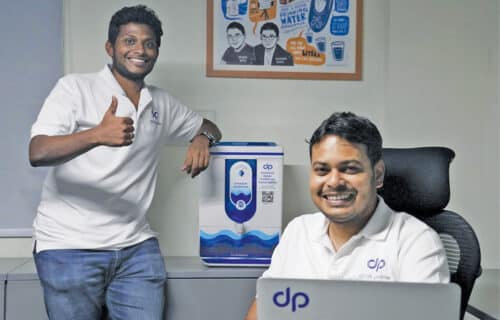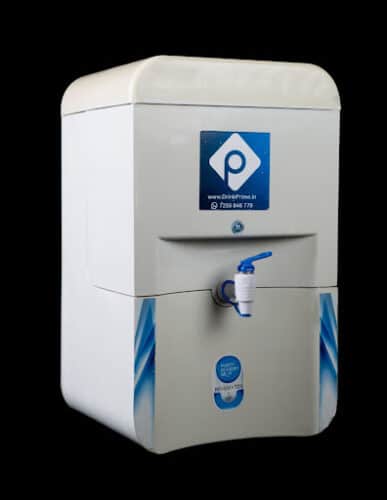“The major problem is that people are not aware of the type of water being consumed. At DrinkPrime, we focus more on the technology needed to perfectly purify water rather than using the same technology to brand our purifiers.”
What exactly is the problem that is being addressed ?
As per UNICEF, less than 50 per cent of the population in India has access to safely managed drinking water. Only 26.3 per cent of Indian households use water purifiers (mostly in the urban areas). In spite of various technologies in the market for over 30 years, there has been no solution that actually provides a perfect solution.
The input water is the core problem that has often been ignored for years. For example, in Bangalore, there are 3 input water sources, namely Kaveri river water, underground water, and tanker water(chlorinated municipal water). Their proportion varies from one area to another, adding to the seasonal changes that occur. Hence the TDS(total dissolved solids) in the water is not the same everywhere. In such a scenario, a one-size-fits-all solution does not help.
Not everyone in the urban areas installs a water purifier, due to affordability and migrant population. To their aid, there is an 85 percent penetration of the bottled water market. The penetration of the purifier market on the other hand is less than 5 percent.
“How can A water purifier solve a problem without even knowing the problem completely?”
How is the problem being addressed ?
Unlike the current water purifiers, DrinkPrime focuses on relevant purification of the input water. Started in 2016, we target the root cause of the problem. Taking a different direction from the one-size-fits-all concept, the IoT sensors enabled in the purifier are connected to WiFi, giving a continuous stream of data and keeping track of the purity of water.
Our water purifiers are smart enough to know the right purification based on the input water. Customised solutions are offered to customers based on the input water. The technology of purification to be used is selected accordingly.
“The good range for drinking water on a TDS metre is between 50-150. However, it gives only a measure of total dissolved solids in water, and not the minerals involved. It is an estimate and not a complete measure.”
“We are working on measuring the minerals in the water and not solids.”
Why is the problem being addressed ?
We believe that water purifiers are not an appliance but a utility. Awareness is one of our campaigns that we are working on, in letting people know the importance of having purified drinking water. We are looking to have a concept of litmus test strips being given out, where people can casually test the quality of water and take their call. It would be good to have partners who can back us up technically in this area.
Our concept is like the electricity board, to only charge customers for the best output being offered, irrespective of the type of purification. We look to penetrate into 70 percent of the market, where people are provided with safe drinking water. At later stages even a pipeline can be placed for a group of houses.
What makes the solution being offered unique?
The purifier consists of solenoid walls that prevent air from passing through, making the water in the purifier – safe to drink- for as long as 2 months. In case of the purifier being unused for more than 2-3 months, a technician reverse flushes the device once.
Figure 1: Version 1 of the purifier
The first model (figure 1) of the purifier was GSM-based, but very soon we realised there were connectivity issues and customers had trouble knowing the level of water in the purifier. The upgraded version, apart from showing the level of water, solved many issues, as it moved from GSM to a Bluetooth model. However we saw that the taste started differing with purification and upgraded the quality and carbon. As sales grew, customers wanted proper maintenance in terms of cleaning the device. Hence our third version, comes with a detachable tank and also reduces the noise that components were making. We were now clear that the products we used for manufacturing needed area level supervision. The third version of the purifier now had a 10 litre storage capacity where the speed of filtration could be slow. This is now being shipped and the fourth is being worked on. We are looking at showing consumers the parameters that are being addressed in the purification process.
How is the solution being maintained ?
Our technicians, once in 4 months, check the water purifier to see if something should be reconfigured or changed. This helps us keep track of the purifier’s health so that there is a safe output received. We don’t charge the consumer even for their service.
In this pattern, there is no upfront cost or installation charges as well.

Figure 2 : Manas and Vijender with the third version of the water purifier
How is your pricing to customers?
Our price is Rs 1-3 per litre. As consumption increases the price drops down from Rs.3/litre to Rs.1/Litre, when compared to the bottled water market (Rs.4/litre) and the general purifier market (Rs.4-6/litre).
Eliminating the cost needed for a one-time investment, the sensors placed inside the purifier can also monitor the quantity of consumed water and charge customers accordingly. Our subscription plans include hardware, installation, service and capital cost. When consumers are away(not using the purifier), we also have a “Pause” period, where only the financing fee is charged. There are a few plans that give a 15 day off upfront pause, where the fee is not charged.
Affordability is a big part of the organisation. In comparison to the dealer-distributor pattern, which is quite expensive, we focus on a D2C model, making this technology available to all.
Where is your consumer base?
Tenants are our major customers. We are also working with the landlords regarding the water purifier device. We advise them to keep the purifier, so that the next tenant takes it. Small initiatives in converting the owner to a customer are also being taken, making it beneficial as a revenue source for them. A win-win situation for both tenant and owner. So far the consumer base has spread to more than 1 lakh across 7 cities in India (Bangalore, Hyderabad, Delhi, Faridabad, Ghaziabad, Gurgaon and Noida).
When did your journey begin?
We started off a hobby project (named Waterwala) to purify water for consumption in 2014. Our main aim back then was to make purified water delivered to the doorstep. Even though more money was being invested for delivery, while scaling up the model, the consumer base crossed 20k, emphasising the size of the problem, yet we were missing out the main aspect which is the input water condition. Moving into this industry fulltime in 2015, DrinkPrime started off in 2016.
What do your finances and partnerships look like?
Being a D2C, we are currently looking for both financing and technical partners. With the IoT enabled purifier launched in 2018, we have seen a 5 times YoY growth. We as an organisation are open to new ideas and thoughts, especially those who can reduce the cost per litre. Service technicians and customer acquisition partners are also welcomed.
To keep track of the consumption taking place, data is given to our financiers who back us up. A minimum amount on every device is given to the financer. Currently, our financiers are Omidyar Network India and Sequoia Surge (Rs.21 Crore), Alteria Capital (Rs.6 Crore) and UC Inclusive Credit (₹5 crore) and Western Capital (₹3 crore). Our current valuation is Rs. 202.5 crores.
Who is/could be on your team?
In terms of skill sets, we are adding more members to the DrinkPrime family – Product and Technology, Production and Operations teams – to ensure we achieve our goals and milestones. Apart from this we are always hiring for operations and customer service roles.
With around 150 direct employees, the majority (70 percent) is part of the operations and sales. The remaining work on managing functions with around 20 people focussed only on the technology. We have a team of absolute hardware experts that are working on the fourth version and the awareness program.
What are the challenges you face ?
Testing parameters challenge– exists as over 20 parameters are collected from the input water in each area(TDS, turbidity, chloride levels, pH levels, minerals and metals, ecology). Not everything can be done online, as some need to be kept on a solvent adding a catalyst to obtain results, even though TDS and pH can be measured easily.
Supply chain challenge– is something always present. The reliance on international imports, 24 hrs testing are challenges which are offline and time consuming. We would be happy to collaborate in a cost effective way with people who have cracked and found a solution to this. Being a hygiene factor and a utility, the consumer would not pay extra for this, hence cost plays a vital role.
Innovation challenge– is increasing the life of the water purifier, making it more durable, in a better fashion.
What are your future plans?
As water purification is a whole necessity in India, we look to expand even to rural areas. As time progresses, we would like to provide water at less than Rs 1/litre or set up an area for a community where people could fill water in rural India. We are looking at tier 1 cities first, followed by tier 2 and tier 3. Our main vision currently, is making sure that the 85 percent of urban India population drinks the right water.
Manas and Vijender come from a MBA and Computer Science background respectively. Transcribed and curated by Sharon Abhignya Katta, who is passionate about innovation.










